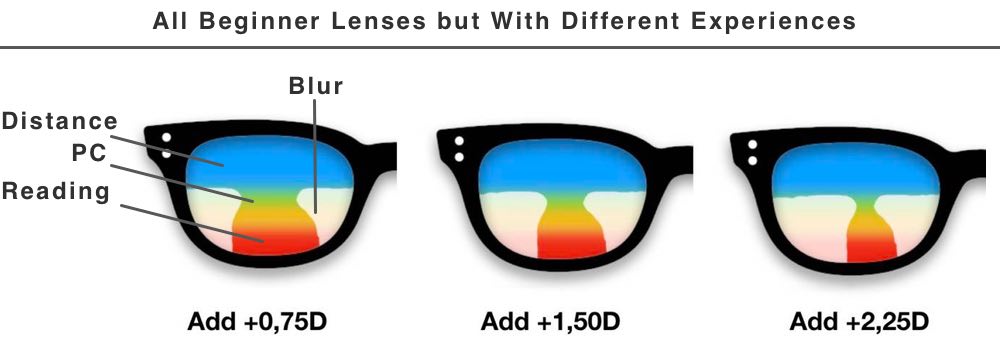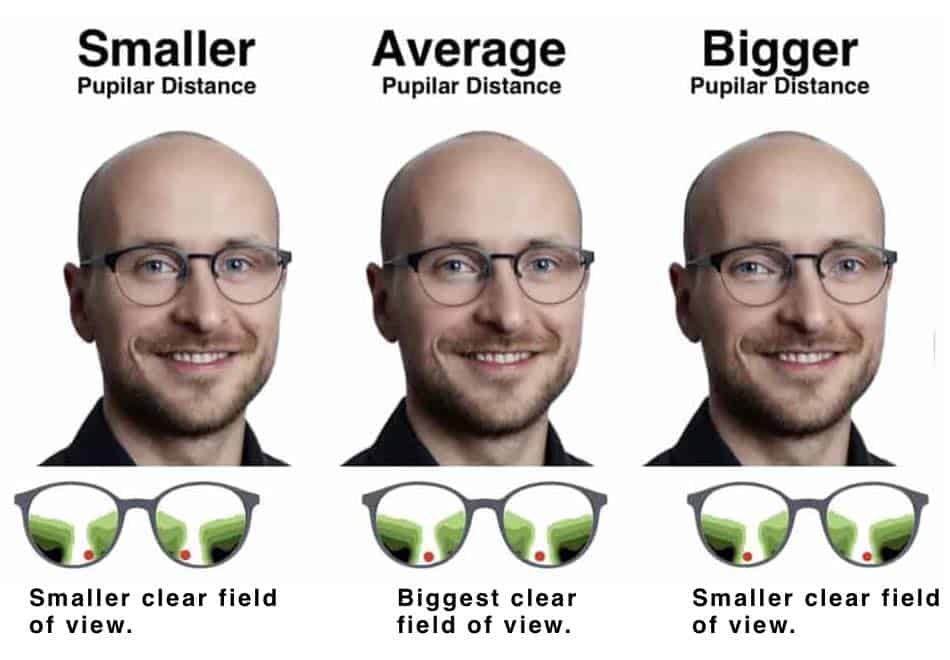When the time has come for you to buy your first progressive lenses a few extra information will help you to decide with what lens, to begin with.
Beginners with progressive lenses have vastly different experiences depending on how well their eyes still can adapt to closer distances. If you start out with progressive lenses as soon as you notice a taxing feeling while reading on some days or while reading in a not so well lit environment you will enjoy an easier start.
Because in this stage your eyes need very little reading support in the lower half of the lenses. The reading support is the Add value in your prescription. An Add value of around +1.00D is low and people in the mid-40s usually have this value. When time passes the eyes gradually lose the ability to focus on closer distances.
More reading support will be adjusted to the needed lens power. When the wearer is in their 60s this Add value is usually around +2.00D. I describe this value and the course of action not only to tell you more lens power will be better as time passes. But one of the most important pieces of information about progressives as a beginner is the clear field of view gets smaller with an increased Add value.

The higher the Add value the more blur you will have in the lower part of the periphery. This is why I told you the experience can vastly differ depending on how much reading support you need.
Beginner or Starter Progressive Lenses – What Does This Actually Mean?
There are a couple of progressive lenses to start with made by the manufacturers. Some of the models are:
- Shamir First PAL
- Essilor Varilux Starter
What those progressive lenses have in common they are more positioned as less price intense products. But therefore they can not be customized to your special needs if your pupillary distance is bigger than normal or smaller than the average of 32mm per side.
If the prescription is not complex this is a good idea. Before I told you about the blur in the lower periphery that is the result of a higher Add value. So if you have a bigger field of view and less blur and distortions there is less need to optimize these lenses.
In some cases, those progressive lenses for beginners are even only available with lower Add values. So you can not order them with a higher Add value than 1,25D. But this is dependent on the manufacturer. So if you are in your 40s and you do not need a lot of reading support this product will probably fit you well.

However, if you are about to buy your first progressive lenses and you are in your 60s you are technically also a beginner. Because you just start out. But watch out on the first picture above what happens to the clear field of view if the Add value changes. It gets a lot smaller!
If this sounds a little too abstract to you. I will give you this example. With a less clear field of view, you will need to point your nose more into the direction you want to see clearly in.
With an Add value of around +2,00D, you can see the screen of your mobile clear if you hold it vertically. If you turn it and you hold the long side horizontally you can expect to see the blur coming up in the periphery of the screen.
If you want a more detailed explanation of what you expect in terms of the clear field of view I have an in-depth article here for you.
What Is the Difference Between Beginner Progressive Lenses and High-End Progressives?
When I do the consulting for progressives for my customers and I tell them about the blur in the periphery they usually tell me to upgrade because of what they saw in a marketing brochure or in the web high-end lenses have no blur and zero distortions in the periphery.
Yeah, what else could I say than advertising and marketing claims do not often represent a realistic image. Really, there is no manufacturer that can produce a progressive lens design without blur in the lower periphery. I would be the first one to write about that here.

But what they can do a lot of things very well. The blur can be minimized to an extend compared to beginner lenses and they can position the reading zones to make sure you get the widest possible view you can technically get.
Those lenses become relevant to you as soon as your prescription for distance vision is usually higher than ±5D or you have higher astigmatisms or you decide to buy a frame that sits somehow more or less tilted in your face.
If your Add value is still low (not higher than +1,50D) but one of those mentioned points comes up it might be a good idea to consider high-end progressives anyways. But most people will really benefit from high-end progressive lenses when their Add value is higher than +1,50D.
When you reach an Add value of +2,00D or even higher the clear field of view gets so small so it makes sense to optimize those fields as good as it gets to provide you with the best visual comfort.
There are a lot of things that get optimized. Even the prescription gets fine-tuned to make sure you will get the most visual acuity out of the lenses. Let’s have look at the example below.
Lens Powers in your Beginner Lenses
| SPH | CYL | A | Add | |
| R | +5,00 | -1,00 | 180 | 2,00 |
| L | +5,00 | -1,00 | 180 | 2,00 |
Lens Powers in your High-End Progressive Lenses
| SPH | CYL | A | Add | |
| R | +4,87 | -1,12 | 174 | 2,00 |
| L | +4,87 | -1,12 | 6 | 2,00 |
So nearly every part of the prescription with the high end lenses got altered to give you the best vision possible. This happens if every angle and distance is measured in which the glasses sit in front of your eyes.
This level of customization is simply not available with beginner progressive lenses in most cases. Depending on what manufacturer you choose you can get a high level of customization with a lower price point too. But if you want to enjoy the durability of the premium coatings from the more price intense manufacturers you need to go with their choices.
Pitfalls to Avoid When Buying Beginner Progressive Lenses
Most people believe the misconception just because they have every distance built into the glasses all distances need to be clear. But that is not the case. You can see clear as long as you look straight ahead and your posture is upright. But when you look straight ahead through the part for distance vision do not expect to see your computer screen any better compared to your single vision glasses for distance vision.
Because there is literally no support for the PC in the upper part of the lenses. There you can find distance vision only. If your eyes can still adapt to this distance within your arm’s length you are good to go using them in front of your PC. But if you need more lens power in this distance you will need a second pair of glasses for the PC or reading.
Adapting to progressives in your 40s is really easy. But if you have a condition in which you need to different lens powers in one eye compared to the other you might run into problems like double vision or headaches.
If you want to know about the possibilities to fine-tune your beginner progressive lenses to avoid those problems I have a troubleshooting guide for progressives written here for you.
Everything you will see there is applicable to beginner progressives too. because in the end, they are just progressive lenses that are not optimized to your individual needs. Beginner progressives have just a simpler lens design.
I wish you a great day.
